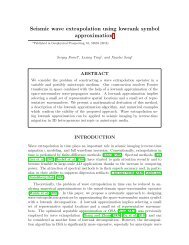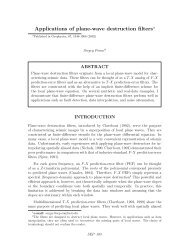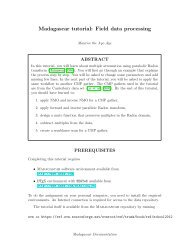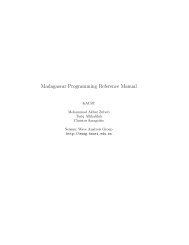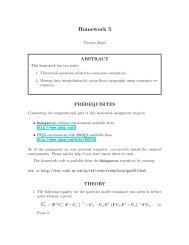Using IWAVE - Madagascar
Using IWAVE - Madagascar
Using IWAVE - Madagascar
Create successful ePaper yourself
Turn your PDF publications into a flip-book with our unique Google optimized e-Paper software.
4<br />
2. These figures display sampled versions of the models with ∆x = ∆z = 5 m; the<br />
model fields are actually given analytically, and can be sampled at any spatial rate.<br />
Symes and Vdovina (2009) use this model to illustrate the interface error phenomenon:<br />
the tendency, first reported by Brown (1984), of all finite difference schemes<br />
for wave propagation to exhibit first order error, regardless of formal order, for models<br />
with material parameter discontinuities. Figure 3 exhibits a shot gather, computed<br />
with a (2,4) (= 2nd order in time, 4th order in space) staggered grid scheme,<br />
∆x = ∆z = 5 m and an appropriate near-optimal time step, acquisition geometry<br />
as described in caption. The same gather computed at different spatial sample<br />
rates seem identical, at first glance, however in fact the sample rate has a considerable<br />
effect. Figures 4 and 5 compare traces computed from models sampled at four<br />
different spatial rates (20 m to 2.5 m), with proportional time steps. The scheme<br />
used is formally 2nd order convergent like the original 2nd order scheme suggested<br />
by Virieux (1984), but has better dispersion suppression due to the use of 4th order<br />
spatial derivative approximation. Nonetheless, the figures clearly show the first order<br />
error, in the form of a grid-dependent time shift, predicted by Brown (1984).<br />
Generally, even higher order approximation of spatial derivatives yields less dispersive<br />
propagation error, which dominates the finite difference error for smoothly<br />
varying material models. For discontinuous models, the dispersive component of error<br />
is still improved by use of a higher order spatial derivative approximation, but<br />
the first order interface error eventually dominates as the grids are refined. Figure 6<br />
shows the same shot gather as displayed earlier, with the same spatial and temporal<br />
sampling and acquisition geometry, but computed via the (2,8) (8th order in space)<br />
scheme. The two gather figures are difficult to disinguish. The trace details (Figures<br />
7, 8) show clearly that while the coarse grid simulation is more accurate than the<br />
(2,4) result, but the convergence rate stalls out to 1st order as the grid as refined,<br />
and for fine grids the (2,4) and (2,8) schemes produce very similar results: dispersion<br />
error has been suppressed, and what remains is due to the presence of model<br />
discontinuities.<br />
See (Symes and Vdovina, 2009) for more examples, analysis, and discussion, also<br />
(Fehler and Keliher, 2011) for an account of consequences for quality control in largescale<br />
simulation.<br />
CREATING THE EXAMPLES - RUNNING <strong>IWAVE</strong><br />
APPLICATIONS<br />
<strong>IWAVE</strong> builds with SConstruct (http://www.scons.org), either as an independent<br />
package or as part of <strong>Madagascar</strong> (Fomel, 2009). For download and install instructions,<br />
see Appendix B and sources cited there.<br />
The examples are also scripted with SConstruct. Providing scripts makes the<br />
results convenient to rebuild, and I’ll first explain how to do that. I also explain how




